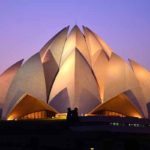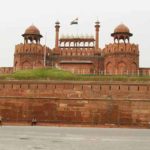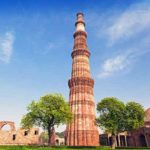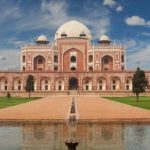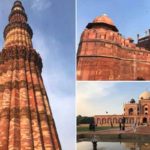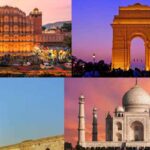Top 10 Places to Visit in Delhi is affectionately referred to as the “City of Cities.” The bustling Indian capital successfully puts the old and new together in one place, creating a special melting pot that fascinates everyone. Experience the ancient and the modern coexisting in harmony, strengthening Delhi’s appeal to visitors from all over the world. Delhi, as the country’s main entry point, is in a strategic location.
It has excellent international and domestic connections. While Delhi offers plenty to see, do, and experience, it also serves as a gateway to Rajasthan, Central India, North India, and nearly every other city in the world. As a result, it’s no surprise that it’s India’s most popular tourist circuit, Agra and Jaipur are included in the Golden Triangle, which begins in Top 10 Places to Visit in Delhi.
The history of the land is as intriguing as Delhi. The city has been the centre of many ruling dynasties who have chosen it as their seat of power over centuries and periods. Unsurprisingly, today’s Delhi is made up of seven cities. Lalkot was founded in the mid-eleventh century, and only a few ruins remain today. Siri, founded by Allauddin Khilji, has some ruins that have been designated as UNESCO World Heritage Sites.
The Tughlaks built Tughlakabad and Ferozabad, which are now intriguing ruins. Then there was the city of the Lodis, which has interesting architecture to admire as well. Finally, Shahjahanabad, the magnificent capital of the Mughals under Shah Jahan, was among the last of the glorious bygone days. With many interesting monuments, New Delhi, also known as Lutyen’s Delhi, represents the legacy of the British. Inadvertently, you will come across the glorious past in every nook and cranny you visit.
Aside from the old, the modern isn’t far behind, as the city keeps up with the rest of the world. Fine-dining restaurants, business centres, shopping malls, museums & art galleries, internationally renowned hotels, and other attractions have helped to bring the city on the map around the world. The Humayun’s Tomb, Red Fort, Jama Masjid, and Qutub Minar Archaeological Complex are some of the most interesting places to see in Delhi, Among the many attractions are the Jantar Mantar, the Bahai Temple, Raj Ghat, and India Gate.
Aside from the incredible sights, Delhi is a fantastic shopping destination. Shopping is a major attraction for visitors to Delhi, whether it’s the roadside stalls of Connaught Place or the swanky shopping malls in the suburbs. The same can be said about the food. Be it the street food of Old Delhi bylanes or the luxury restaurants, every dish is a treat for your taste buds, Top 10 Places to Visit in Delhi.
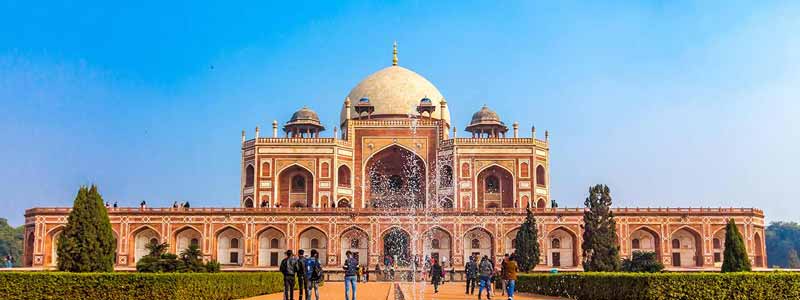
Humayun’s Tomb
Humayun’s tomb in Delhi’s capital is a fine example of Mughal architecture. The tomb, which was built in 1570, is culturally significant because it was the first garden-tomb on the Indian subcontinent. Its extraordinary beauty is said to have sparked several major architectural breakthroughs, culminating in the construction of the Taj Mahal. In many ways, this beautiful red and white sandstone structure rivals Agra’s famous “monument to love.” At a cost of about 1.5 million, Humayun’s queen Hamida Banu Begam (Haji Begam) erected this historic monument. The tomb is thought to have been conceived by her Top 10 Places to Visit in Delhi.
The grandeur of this memorial is immediately apparent as soon as you enter the grandiose double-storeyed gateway. A square garden is encircled by high rubble walls and divided into four large squares by causeways and water channels. Each square is divided into smaller squares by paths, creating a Charbagh, a typical Mughal garden. The fountains were created using simple yet sophisticated engineering skills that were prevalent in India at the time. During the first War of Independence in 1857, the last Mughal emperor, Bahadur Shah Zafar II, sought refuge in this tomb. Several Mughal dynasty rulers are buried here. Humayun‘s widow is also interred here.
The principal sarcophagus is located in the central hall and is oriented north-south in accordance with Muslim tradition. The body is traditionally positioned with the head facing north and the face turned sideways towards Mecca. The dome is a full dome, which is a complete semi-circle and a unique feature of Mughal architecture. The structure is made of red sandstone, but the borders are made of white and black marble. This magnificent masterpiece has been designated as a world heritage site by UNESCO.
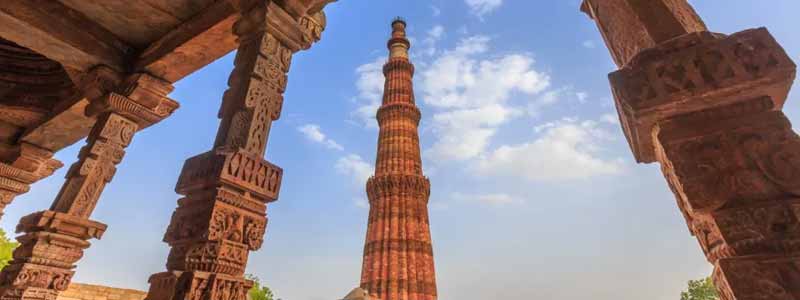
Qutub Minar
In 1993, the Qutub Minar and other monuments in the complex in Delhi were designated as a UNESCO World Heritage Site. The tower, known as the Minar, is made partly of red sandstone and partly of marble and sandstone, and it stands at a height of 72.5 metres, which was very impressive in the 13th century. The adjacent 5th century Mehrauli Iron Pillar is also worth seeing. It is known as Ashoka Pillar and is a marvel, Even today, it hasn’t rusted.
People in the area think that if you stand with your back to the pillar and wrap your hands around it, any wish you make will be granted. No one is allowed to touch the pillar or test the truth. In 1199 AD, Qutb-ud-Din Aibak laid the foundation for Qutab Minar and raised the first storey. Shamsu’d-Din Iltutmish, his successor and son-in-law, completed the building and added three more storeys. The tower consisted of five storeys in total. It was intended for Islamic priests to use to make their morning calls.
For many years, Qutub Minar was India’s highest stone tower, and it is regarded as one of the finest Islamic structures ever built in India. It has elaborate carvings and inscriptions of Koranic verses on it. Beautiful calligraphy can also be found on nearby buildings. Each of its toreys had a balcony that extended outward. The original Minar had only four storeys, according to legend, but the uppermost storey was destroyed by lightning in 1368, during Feroze Tughluq’s reign, He added two storeys to the tower, giving it a total of five storeys Top 10 Places to Visit in Delhi.
The tower was built to commemorate Qutub-ud-Din Aibak’s conquest, though some historians argue that it was actually a minaret for the nearby mosque. It tapers from 14.32 m at the bottom to 2.75 m at the top. Nearby are the tombs of Adham Khan and Zafar Mahal, as well as Jamali-Kamali.
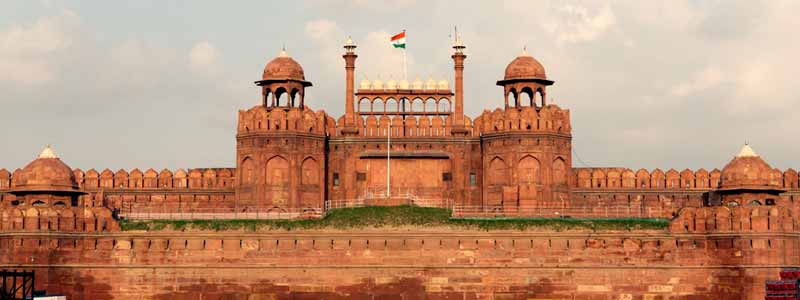
Red Fort
The Red Fort in Delhi is known for the red stone with which it is constructed, and it is one of the most beautiful palaces in the world. This fort is also intertwined with India’s history. The British deposed the last Mughal ruler, Bhadur Shah Zafar, from here, bringing the Mughal rule to an end after three centuries. It was also from its ramparts that India’s first Prime Minister, Pandit Jawharlal Nehru, declared the country’s independence from colonial rule.
After ruling from Agra for eleven years, Mughal emperor Shah Jahan decided to move to Delhi and laid the foundation stone of the Red Fort in 1618. The palace’s main halls were draped in rich tapestry and covered in silk from China and velvet from Turkey for its 1647 inauguration. The fort is an irregular octagon with a circumference of nearly one and a half miles and two entrances, the Lahore and Delhi Gates.
Visitors may enter the Chatta Chowk (vaulted arcade) from the Lahore Gate, which was once a royal market and housed court jewellers, miniature painters, carpet makers, enamel workers, silk weavers, and families of specialised craftsmen. The royal band played five times a day at the Nawabarkhana (band house) on the road leading from the royal market. All visitors, except royalty, were required to dismount at the band house before entering the main palace.
The Red Fort’s public audience hall is known as the Diwan-e-Aam. The 80 x 40 foot hall is separated by columns and is made of sandstone with shell plaster polished to look like ivory. Mughal emperors would hold court and meet with dignitaries and foreign emissaries here. The alcove in the back wall where the emperor sat in state on a richly carved and inlaid marble platform is the most imposing feature of the Diwan-e-Aam. Fine examples of Italian pietra-dura work can be found in the recess behind the platform.
The Diwan-e-Khas was the fort’s mainstay, serving as a private audience hall. The 90 x 67-foot building is the most ornate of all Shah Jahan’s structures. The Diwan-e-Khas is a white marble pavilion with intricately carved pillars. The emperor was so taken with the beauty of this pavilion that he had the words “If there is heaven on the face of this earth, it is this, it is this” inscribed on it.
The renowned Peacock Throne, which was valued at six million sterling when it was plundered by Nadir Shah in 1739, was once housed in the Diwan-e-Khas, which was richly decorated with flowers of inlaid mosaic work of cornelian and other stones, Top 10 Places to Visit in Delhi.
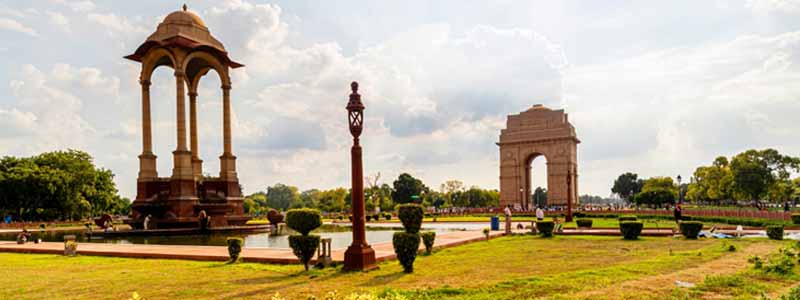
India Gate
The All India War Memorial, also known as India Gate, is a 42-meter-high sandstone giant gate designed by renowned war memorial architect Edwin Lutyens in 1921. It is a war memorial located on the Rajpath, which is at the eastern end of Kingsway. It is a monument to World War I martyrs (1914-21). During Bangladesh’s liberation period, Under the India Gate, a structure was built that included a black marble plinth, a reversed L1A1 rifle, a war helmet, and four urns that ignited the permanent light.
The Amar Jawan Jyoti is the name of this structure. It was inaugurated by then-Prime Minister Indira Gandhi on the 23rd Republic Day in 1972. Since then, Amar Jawan Jyoti has served as a memorial to the known and unknown Indian martyrs who gave their lives in the service of their country. On the monuments are inscribed the names of over 13,000 Indian martyrs.
The current administration intends to build a national war memorial near the India Gate canopy, which recently saw the removal of George V’s statue, which was later relocated to the coronation garden.
People who visit India Gate feel a strong sense of patriotism. It is one of the most popular tourist destinations in New Delhi, with a large children’s park and a boating club. It’s a great spot for a picnic. India Gate is also known for hosting a number of marches and rallies.
Lodhi Garden
In the midst of Delhi’s hustle and bustle, Lodi Gardens is a true haven of tranquilly. Tourists and locals alike visit the famous historical park, which is spread out over 80 acres. The four monuments of the Lodi dynasty, the last of the Delhi Sultanate, are the inspiration for the gardens. It was built during the British period and opened to the public on April 9th, 1936, by Lady Willingdon.
The monuments that surround the Lodhi gardens date from the 15th and 16th centuries. Ala-ud-din Alam Shah erected the tomb of Mohammed Shah, the last of the Sayyid rulers, in 1444 as a tribute to Muhammed Shah. During the reign of Sikander Lodi, the Bara Gumbad and the adjacent mosque were built in 1494. The Glazed Dome, also known as the Sheesh Gumbad, was built around the same time but is smaller in size. Ibrahim Lodi built Sikander Lodi’s tomb in 1517. Except for the addition of chhatris along the dome, it bears a striking similarity to Mohammed Shah’s tomb.
The eight-pillared ‘Atha pula Bridge’ is worth mentioning. The seven arches of the bridge under which the waters of a lake flow are supported by these eight pillars. Swans can be found in these waters. For a better view, head down to the lake.
Lodhi Gardens is known for its extensive tree collection. Neem, Amaltas, Moulshree, Peepal, Bargad, Gulmohar, Ashok, Silver oak, Magnolia, and other varieties can be seen. Birds such as babblers, parakeets, mynahs, kites, owls, and kingfishers live in the garden.
The gardens have become a popular morning and evening jogging destination. The complex also has an open gym where you can work out. Visit the gardens for a stroll, a run, or simply to commune with nature.
Rashtrapati Bhawan
Rashtrapati Bhawan, the President of India’s official residence, is the city’s most visible monument. The building is decorated with classical motifs that symbolise legacy and authority, and it was built in the Edwardian baroque style of architecture. Rashtrapati Bhawan is a 321-acre complex with 340 rooms, including guest rooms, reception halls, and offices, stables and residences for staff and bodyguards.
Rashtrapati Bhawan, also known as the Presidential Residence and Viceroy’s House, was built in 1929. It was formerly the residence of the British Viceroy. This architectural marvel took 17 years to complete. Edward Lutyens and Herbert Baker conceived the Rashtrapati Bhawan. The Bhawan’s renowned Mughal Gardens cover 15 acres and feature 159 different rose varieties, There are 60 different varieties of bougainvillaea, as well as many other flower varieties. A visit to the Rashtrapati Bhawan Museum Complex (RBMC) is also worthwhile.
An old Presidential buggy, pulled by life-size horses, is a major attraction. You can also see a Mercedes car that the Jordanian king gave to former Prime Minister Rajiv Gandhi. To get a better understanding of history, Rare photos of the Bhawan and the freedom movement are hung on a table for visitors to see. A gift counter on the premises displays the gifts that the President has received from around the world. Tourists would be especially enthralled by a special square box containing 3-D holographic images that play alongside various Presidents’ speeches. Several windows in the museum display the Presidents’ personal effects Top 10 Places to Visit in Delhi.
Mahatma Gandhi visited Rashtrapati Bhawan in 1931, when he was invited by Lord Irwin, and brought a pinch of salt as a symbol of protest against the British. The Gandhi-Irwin Pact of 1931 was the result of the meeting.
Lotus Temple
Baha’i Temple is another name for Lotus Temple. It is constructed in the shape of a Lotus flower and stands at a height of about 40 metres. In the year 1986, the structure was finalised. It is such a lovely structure that one can admire it from afar as well. The Baha’i family owns the memorial, which is a sacred site. It is made up of clean white marbles in the shape of a figure of not completely opened lotus.
There are 27 giant white marble petals in the shape of a lotus. It is formed by nine pools and walkways.’ Any religion is welcome to come here and acquire spiritual knowledge. Inside the corridor, they will find peace and pray. Everyone is welcome to visit the lotus temple. It is open from 9:30 a.m. to 5:30 a.m. Because the area is so calm, it provides a lot of value to mediators. The lotus is a religious and purity symbol. A prayer hall is a large room on the inside.
Akshardham Temple Delhi
The Akshardham temple is one of India’s most famous and amazing tourist attractions. Akshardham, known for its beauty and large area, has many characteristics that describe human existence and motivation. The history of Akshardham temple includes the fate of humanity as well as information about the universe. This location is not only known as a temple, but also as a place of enlightenment, according to researchers, education and entertainment.
Akshardham’s entire area is 23 acres, and it includes parks, rides, lakes, sculptures, and shrines that are flooded throughout the temple. All of these things sum up the entire experience of India’s rich culture and heritage. The history of the Akshardham temple is dedicated to Lord Swaminarayan and is inspired by Pujya Pramukh Swami Maharaj. Thousands of people and volunteers have contributed money and time to build Akshardham, a miraculous structure that explores religion’s rich culture.
Lord Swaminarayan’s devotees work here, spreading and expanding the flavour of spirituality and devotion while maintaining full peace of mind. The perfect impression or imprint of Indian architecture with religious culture is presented by this monument, which was built using authentic and contemporary methods. The pink sandstone used in the construction comes from Rajasthan. Thousands of these unique stones are carved with historical imprints that tell the storey of India’s rich culture through images and carvings. Because the artists and builders did not use cement or metals like steel, the memorial will last for many years.
Purana Qila
Purana Qila, or Old Fort in Urdu, is located in New Delhi. Shergarh or Sher Fort is the name given to it after the Mughal Emperor Sher Shah Suri, who started the construction.
Purana Qila is said to have been inhabited for the past 2,500 years, and excavations at the site have uncovered pre-Mauryan era materials.
The construction of the current citadel began during the reign of Humayun and was completed by Sher Shah Suri. According to the Mahabharata, the fort was constructed on the site of Indraprastha, which was the capital of the Pandavas’ kingdom.
The Bara Darwaza, or Big Gate, facing west, is one of three gateways on this 1.5 km long construction site, the Talaqqi Gate, also known as the prohibited gate, and the Humayun Gate, which faces south.
All of the gates are two-story structures with massive semi-circular bastions flanking either side.
The fort’s gates and bastions are both decorated with white and blue-tiled marbles, adding to the fort’s aesthetic appeal. Purana Qila is a heritage site because of its similarity to Rajasthani architecture, as well as the Islamic architecture from the Mughal period.
Jantar Mantar, Delhi
Jantar Mantar is an astronomical observatory in Delhi, India’s capital. This architectural marvel resembles a large sundial. This observatory appears to have aided the study of time and space since its construction. The foundation stone of this magnificent structure was laid by Maharaja Jai Singh in the year 1724. Similarly, we now have four additional observatories in the cities of Varanasi, Jaipur, Mathura, and Ujjain.
The preparation of astronomical charts was the main goal of this enormous observatory’s construction. These were then used to keep track of the local time zones by watching the sun’s movement and transitions, Our solar system is made up of the moon and various planets. As a result, a highly valuable observatory from the past never ceases to astound technology-influenced astronomers and researchers.
The Jantar Mantar in Delhi stands at a towering 723 feet and is made up of 13 different astronomical instruments. The most valuable and well-known of these are the Samrat Yantra, Misra Yantra, Ram Yantra, and Jai Prakash Yantra. The sundial, which is the main attraction here, is heavily influenced by the Ptolemaic Structure of ancient Egypt. It strictly follows the celestial orders of the equatorial, ecliptic, and horizontal-zenith planes in their local arrangement.
As a result, Delhi’s Jantar Mantar brings the three dimensions of belief, universe, and society closer together. It combines elements of astronomical knowledge with cosmological ideas developed in the court of a learned prince Top 10 Places to Visit in Delhi.


